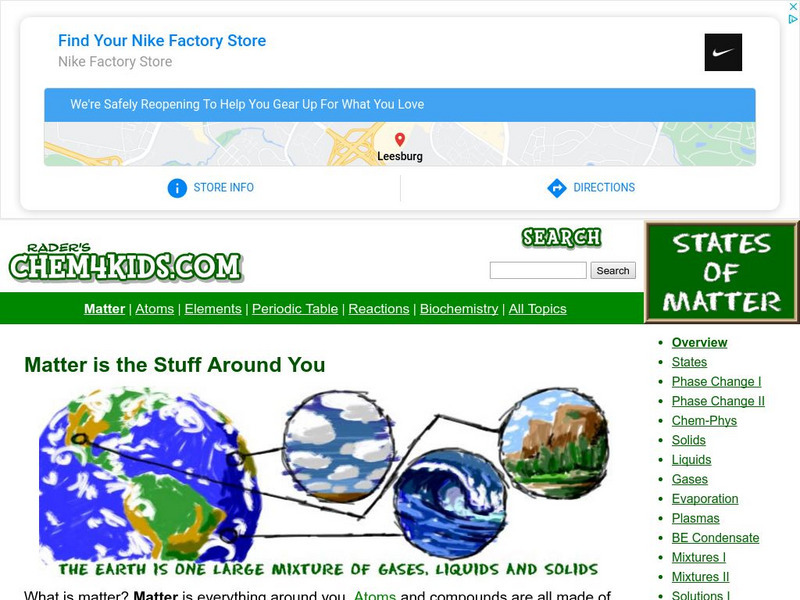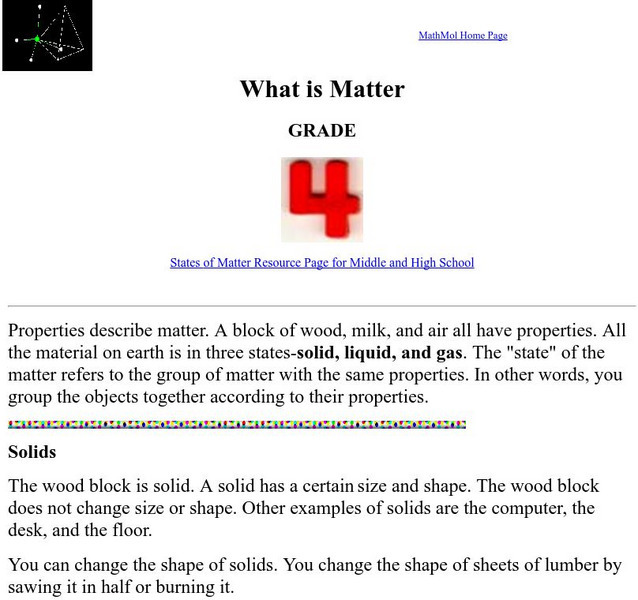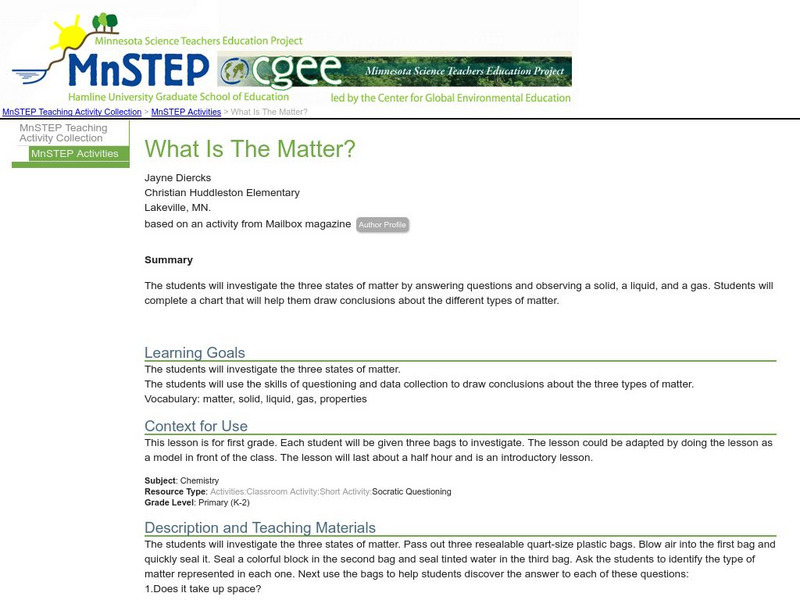Hi, what do you want to do?
Chem4kids
Chem4 Kids: Matter
"Matter is everything." So begins this comprehensive website on the physical and chemical properties of matter in its four main states: solids, liquids, gases, and plasmas. The text is large and easy-to-read. Students will enjoy the...
Science Education Resource Center at Carleton College
Serc: Mn Step: Solids and Liquids Stations
A description of a lesson where students navigate through twelve stations on solids and liquids and record their observations in a booklet. The station topics are listed, but the recording booklet materials were purchased from...
Science Education Resource Center at Carleton College
Serc: Freezing and Phase Change: How Do You Make Ice Cream?
Learners will be expanding a study of phase changes after experiences with exploration of the three phases of matter. They apply what they have learned through freezing water and create a tasty ice cream treat.
Science and Mathematics Initiative for Learning Enhancement (SMILE)
Smile: Physical and Chemical Changes
This lesson plan focuses on the difference between physical and chemical changes of matter.
Georgia Department of Education
Ga Virtual Learning: Fluids
In this interactive module you will be introduced to a unit on fluid dynamics. Learn how an object's density relates to its mass and volume by completing various activities and interactives.
New York University
New York University: What Is Matter?
At this resource discover the difference between solids, liquids, and gases. Practice what you just learned with included review questions.
ClassFlow
Class Flow: What's the Matter?
[Free Registration/Login Required] This flipchart is an introduction to investigating matter: solids, liquids, and gases.
ClassFlow
Class Flow: Matter 2nd Grade
[Free Registration/Login Required] Interactive flipchart teaching the states of matter for a 2nd grade classroom containing four topics with several lessons in each one. The topics covered are: matter, solids, liquids, and gases....
ClassFlow
Class Flow: States of Matter Experiment
[Free Registration/Login Required] This flipchart goes through the basics of identifying the different states of matter: solids, liquids, and gases. It also has an exciting (and easy) experiment for students to combine substances, get a...
Concord Consortium
Concord Consortium: Molecular Workbench Showcase: Chemistry, States of Matter
See how gas, liquid, and solid molecules react to external pressure in this simulation. Also see a model of intermolecular motion through elliptical particles.
HotChalk
Hot Chalk: Lesson Plans Page: Science Lesson on Water
This activity will teach students about the three states of water found on our planet: solid, liquid gas. They will learn to distinguish the differences between these states and will be able to give examples of each.
Starfall
Starfall: All About Matter
This lesson focuses on Matter including the three states of matter, the energy that it takes to change the state of matter, and experiments for children to conduct. Students can choose to have any paragraph read to them.
BioEd Online
Bio Ed Online: Making a Water Cycle
In this lesson students are required to observe a simple model of the water cycle constructed of sand and ice in a plastic shoe box.
ArtsNow
Arts Now Learning: States of Matter [Pdf]
In this lesson plan, students will move and generate choreography to understand different states of matter.
Other
Howto smile.org: From Gas to Liquid to Solid
Allow your students to explore states of matter as they learn what causes frost to form on the outside of a cold container. Students will observe how liquid water can change to ice or water vapor in this lab. Lesson includes background...
Texas Education Agency
Texas Gateway: Phase Changes
Learn how to interpret a phase diagram, explain Dalton's Law, and describe the state of equilibrium between a liquid and a gas, a liquid and a solid, and a gas and a solid. This resource contains in-depth explanations and multiple...
Science Education Resource Center at Carleton College
Serc: Mn Step: State of Matter of an Unknown Material
For this activity, students are given a 'mysterious substance' made of cornstarch and water, and they must test it using common materials such as vinegar or water, to see if they can determine whether it is a solid, liquid, or gas. Their...
Curated OER
Matter
A brief site which defines solids, liquids and gases along with a drawing of each.
Science Education Resource Center at Carleton College
Serc: Mn Step: What Is the Matter?
Students will examine a solid, a liquid, and a gas to gather information and draw conclusions about the three states of matter.
PBS
Pbs Learning Media: Mechanical Waves
Learn about mechanical waves, which transfers energy from one place to another through liquids, gases and solids, with this interactive lesson.
Science and Mathematics Initiative for Learning Enhancement (SMILE)
Smile: Three States of Matter
Teachers can find an interactive lesson plan for introducing the three states of matter to the early elementary student using items that they are familiar with. This also includes gathering data and filling in a table, an important part...
University of Oxford (UK)
University of Oxford: A View From a Distant Universe
An eBook containing information regarding states of matter as it applies to celestial bodies and a universe.
PBS
Pbs Learning Media: Mystery Mud: Exploring Changes in States of Matter
Join a group of middle-school students on a visit to a laboratory at the Massachusetts Institute of Technology, where they experiment with "mystery mud" and learn about the relationships between magnetism, particle motion, and changes in...
Museum of Science
The Atom's Family: Phases of Matter
Help the Phantom choose a material and observe the changes at different temperatures in the molecule chamber. What happens to the elements or molecules as the temperature changes?
Other popular searches
- Solids Liquids and Gases
- Solids, Liquids and Gases
- Solids, Liquids, and Gases
- Solids Liquids and Gasses
- Solids, Liquids and Gasses
- Liquids Solids and Gas
- Solid,s Liquids and Gases
- Liquids, Solids and Gases





















